A Critical Study on Agile Leadership - Research Project Proposal
VerifiedAdded on 2023/06/08
|7
|2777
|59
AI Summary
This research project proposal sheds light on the issues and challenges of agile leadership while giving a closer attention on its practical implication in many organizations. It identifies the reasons behind the issues and challenges of agile leadership faced by giant companies like Google, Amazon and so on. The primary aim of the research will be identifying the issues and challenges of agile leadership style faced by the giant companies like Google, Amazon and so on.
Contribute Materials
Your contribution can guide someone’s learning journey. Share your
documents today.
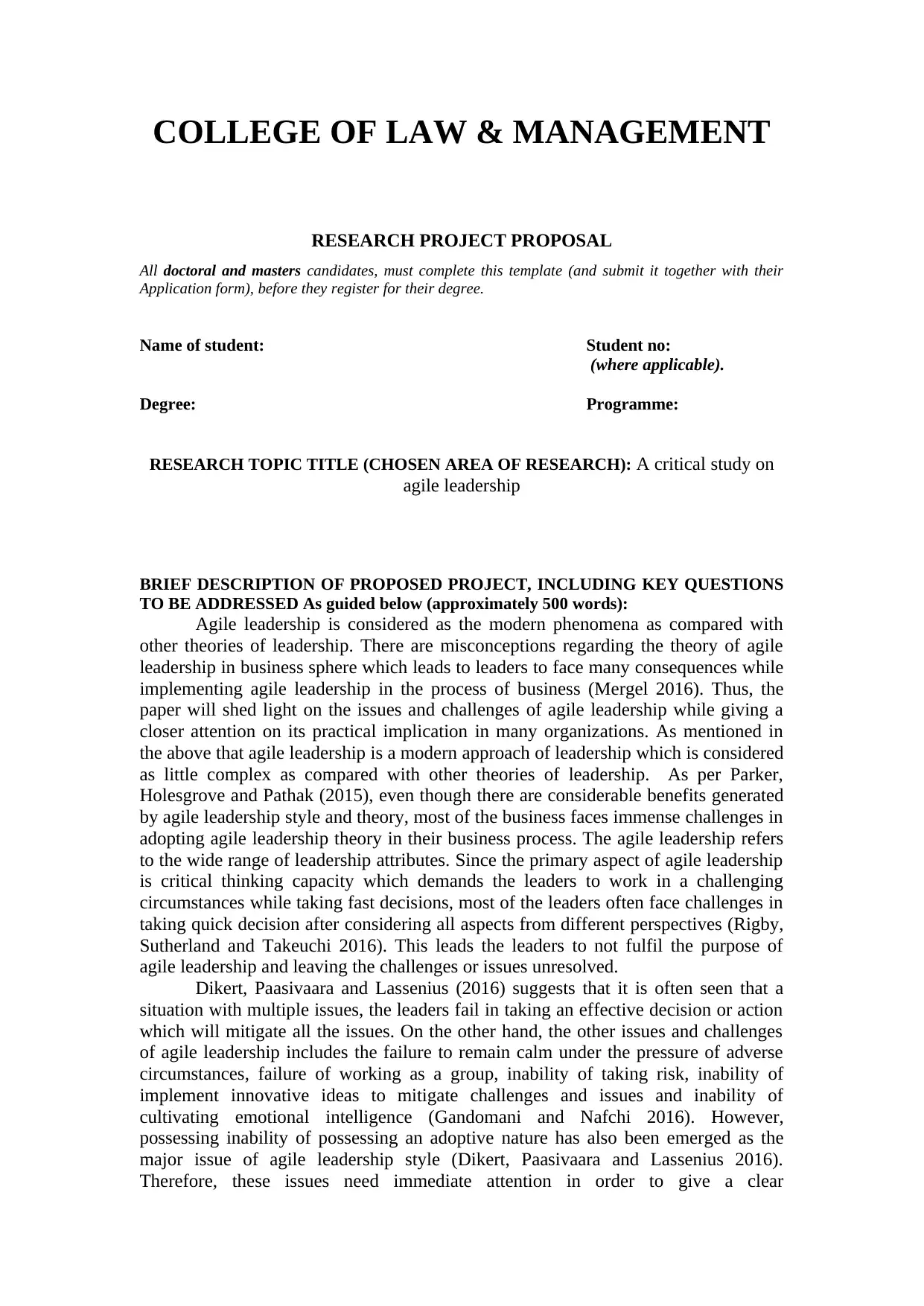
COLLEGE OF LAW & MANAGEMENT
RESEARCH PROJECT PROPOSAL
All doctoral and masters candidates, must complete this template (and submit it together with their
Application form), before they register for their degree.
Name of student: Student no:
(where applicable).
Degree: Programme:
RESEARCH TOPIC TITLE (CHOSEN AREA OF RESEARCH): A critical study on
agile leadership
BRIEF DESCRIPTION OF PROPOSED PROJECT, INCLUDING KEY QUESTIONS
TO BE ADDRESSED As guided below (approximately 500 words):
Agile leadership is considered as the modern phenomena as compared with
other theories of leadership. There are misconceptions regarding the theory of agile
leadership in business sphere which leads to leaders to face many consequences while
implementing agile leadership in the process of business (Mergel 2016). Thus, the
paper will shed light on the issues and challenges of agile leadership while giving a
closer attention on its practical implication in many organizations. As mentioned in
the above that agile leadership is a modern approach of leadership which is considered
as little complex as compared with other theories of leadership. As per Parker,
Holesgrove and Pathak (2015), even though there are considerable benefits generated
by agile leadership style and theory, most of the business faces immense challenges in
adopting agile leadership theory in their business process. The agile leadership refers
to the wide range of leadership attributes. Since the primary aspect of agile leadership
is critical thinking capacity which demands the leaders to work in a challenging
circumstances while taking fast decisions, most of the leaders often face challenges in
taking quick decision after considering all aspects from different perspectives (Rigby,
Sutherland and Takeuchi 2016). This leads the leaders to not fulfil the purpose of
agile leadership and leaving the challenges or issues unresolved.
Dikert, Paasivaara and Lassenius (2016) suggests that it is often seen that a
situation with multiple issues, the leaders fail in taking an effective decision or action
which will mitigate all the issues. On the other hand, the other issues and challenges
of agile leadership includes the failure to remain calm under the pressure of adverse
circumstances, failure of working as a group, inability of taking risk, inability of
implement innovative ideas to mitigate challenges and issues and inability of
cultivating emotional intelligence (Gandomani and Nafchi 2016). However,
possessing inability of possessing an adoptive nature has also been emerged as the
major issue of agile leadership style (Dikert, Paasivaara and Lassenius 2016).
Therefore, these issues need immediate attention in order to give a clear
RESEARCH PROJECT PROPOSAL
All doctoral and masters candidates, must complete this template (and submit it together with their
Application form), before they register for their degree.
Name of student: Student no:
(where applicable).
Degree: Programme:
RESEARCH TOPIC TITLE (CHOSEN AREA OF RESEARCH): A critical study on
agile leadership
BRIEF DESCRIPTION OF PROPOSED PROJECT, INCLUDING KEY QUESTIONS
TO BE ADDRESSED As guided below (approximately 500 words):
Agile leadership is considered as the modern phenomena as compared with
other theories of leadership. There are misconceptions regarding the theory of agile
leadership in business sphere which leads to leaders to face many consequences while
implementing agile leadership in the process of business (Mergel 2016). Thus, the
paper will shed light on the issues and challenges of agile leadership while giving a
closer attention on its practical implication in many organizations. As mentioned in
the above that agile leadership is a modern approach of leadership which is considered
as little complex as compared with other theories of leadership. As per Parker,
Holesgrove and Pathak (2015), even though there are considerable benefits generated
by agile leadership style and theory, most of the business faces immense challenges in
adopting agile leadership theory in their business process. The agile leadership refers
to the wide range of leadership attributes. Since the primary aspect of agile leadership
is critical thinking capacity which demands the leaders to work in a challenging
circumstances while taking fast decisions, most of the leaders often face challenges in
taking quick decision after considering all aspects from different perspectives (Rigby,
Sutherland and Takeuchi 2016). This leads the leaders to not fulfil the purpose of
agile leadership and leaving the challenges or issues unresolved.
Dikert, Paasivaara and Lassenius (2016) suggests that it is often seen that a
situation with multiple issues, the leaders fail in taking an effective decision or action
which will mitigate all the issues. On the other hand, the other issues and challenges
of agile leadership includes the failure to remain calm under the pressure of adverse
circumstances, failure of working as a group, inability of taking risk, inability of
implement innovative ideas to mitigate challenges and issues and inability of
cultivating emotional intelligence (Gandomani and Nafchi 2016). However,
possessing inability of possessing an adoptive nature has also been emerged as the
major issue of agile leadership style (Dikert, Paasivaara and Lassenius 2016).
Therefore, these issues need immediate attention in order to give a clear
Secure Best Marks with AI Grader
Need help grading? Try our AI Grader for instant feedback on your assignments.
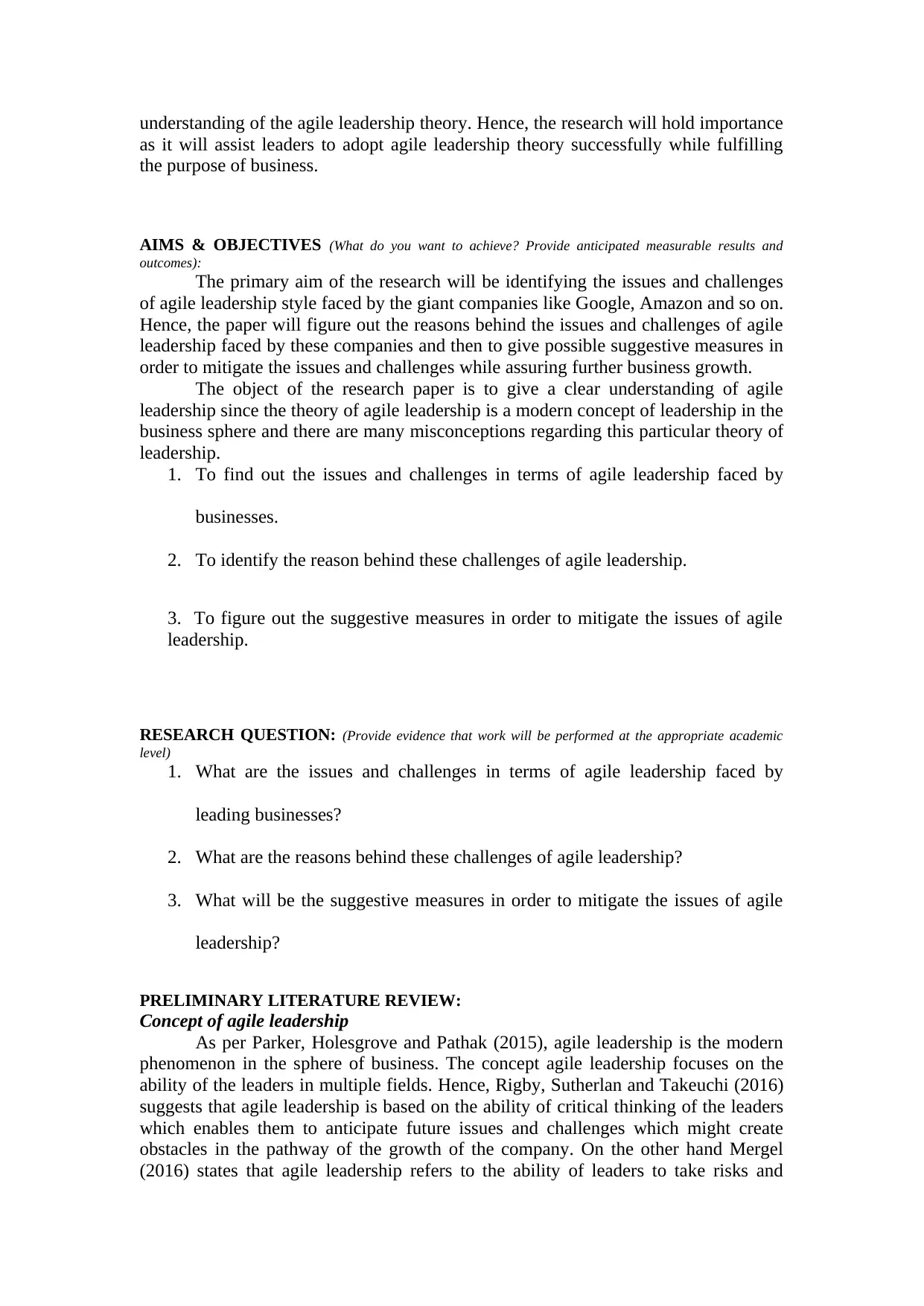
understanding of the agile leadership theory. Hence, the research will hold importance
as it will assist leaders to adopt agile leadership theory successfully while fulfilling
the purpose of business.
AIMS & OBJECTIVES (What do you want to achieve? Provide anticipated measurable results and
outcomes):
The primary aim of the research will be identifying the issues and challenges
of agile leadership style faced by the giant companies like Google, Amazon and so on.
Hence, the paper will figure out the reasons behind the issues and challenges of agile
leadership faced by these companies and then to give possible suggestive measures in
order to mitigate the issues and challenges while assuring further business growth.
The object of the research paper is to give a clear understanding of agile
leadership since the theory of agile leadership is a modern concept of leadership in the
business sphere and there are many misconceptions regarding this particular theory of
leadership.
1. To find out the issues and challenges in terms of agile leadership faced by
businesses.
2. To identify the reason behind these challenges of agile leadership.
3. To figure out the suggestive measures in order to mitigate the issues of agile
leadership.
RESEARCH QUESTION: (Provide evidence that work will be performed at the appropriate academic
level)
1. What are the issues and challenges in terms of agile leadership faced by
leading businesses?
2. What are the reasons behind these challenges of agile leadership?
3. What will be the suggestive measures in order to mitigate the issues of agile
leadership?
PRELIMINARY LITERATURE REVIEW:
Concept of agile leadership
As per Parker, Holesgrove and Pathak (2015), agile leadership is the modern
phenomenon in the sphere of business. The concept agile leadership focuses on the
ability of the leaders in multiple fields. Hence, Rigby, Sutherlan and Takeuchi (2016)
suggests that agile leadership is based on the ability of critical thinking of the leaders
which enables them to anticipate future issues and challenges which might create
obstacles in the pathway of the growth of the company. On the other hand Mergel
(2016) states that agile leadership refers to the ability of leaders to take risks and
as it will assist leaders to adopt agile leadership theory successfully while fulfilling
the purpose of business.
AIMS & OBJECTIVES (What do you want to achieve? Provide anticipated measurable results and
outcomes):
The primary aim of the research will be identifying the issues and challenges
of agile leadership style faced by the giant companies like Google, Amazon and so on.
Hence, the paper will figure out the reasons behind the issues and challenges of agile
leadership faced by these companies and then to give possible suggestive measures in
order to mitigate the issues and challenges while assuring further business growth.
The object of the research paper is to give a clear understanding of agile
leadership since the theory of agile leadership is a modern concept of leadership in the
business sphere and there are many misconceptions regarding this particular theory of
leadership.
1. To find out the issues and challenges in terms of agile leadership faced by
businesses.
2. To identify the reason behind these challenges of agile leadership.
3. To figure out the suggestive measures in order to mitigate the issues of agile
leadership.
RESEARCH QUESTION: (Provide evidence that work will be performed at the appropriate academic
level)
1. What are the issues and challenges in terms of agile leadership faced by
leading businesses?
2. What are the reasons behind these challenges of agile leadership?
3. What will be the suggestive measures in order to mitigate the issues of agile
leadership?
PRELIMINARY LITERATURE REVIEW:
Concept of agile leadership
As per Parker, Holesgrove and Pathak (2015), agile leadership is the modern
phenomenon in the sphere of business. The concept agile leadership focuses on the
ability of the leaders in multiple fields. Hence, Rigby, Sutherlan and Takeuchi (2016)
suggests that agile leadership is based on the ability of critical thinking of the leaders
which enables them to anticipate future issues and challenges which might create
obstacles in the pathway of the growth of the company. On the other hand Mergel
(2016) states that agile leadership refers to the ability of leaders to take risks and
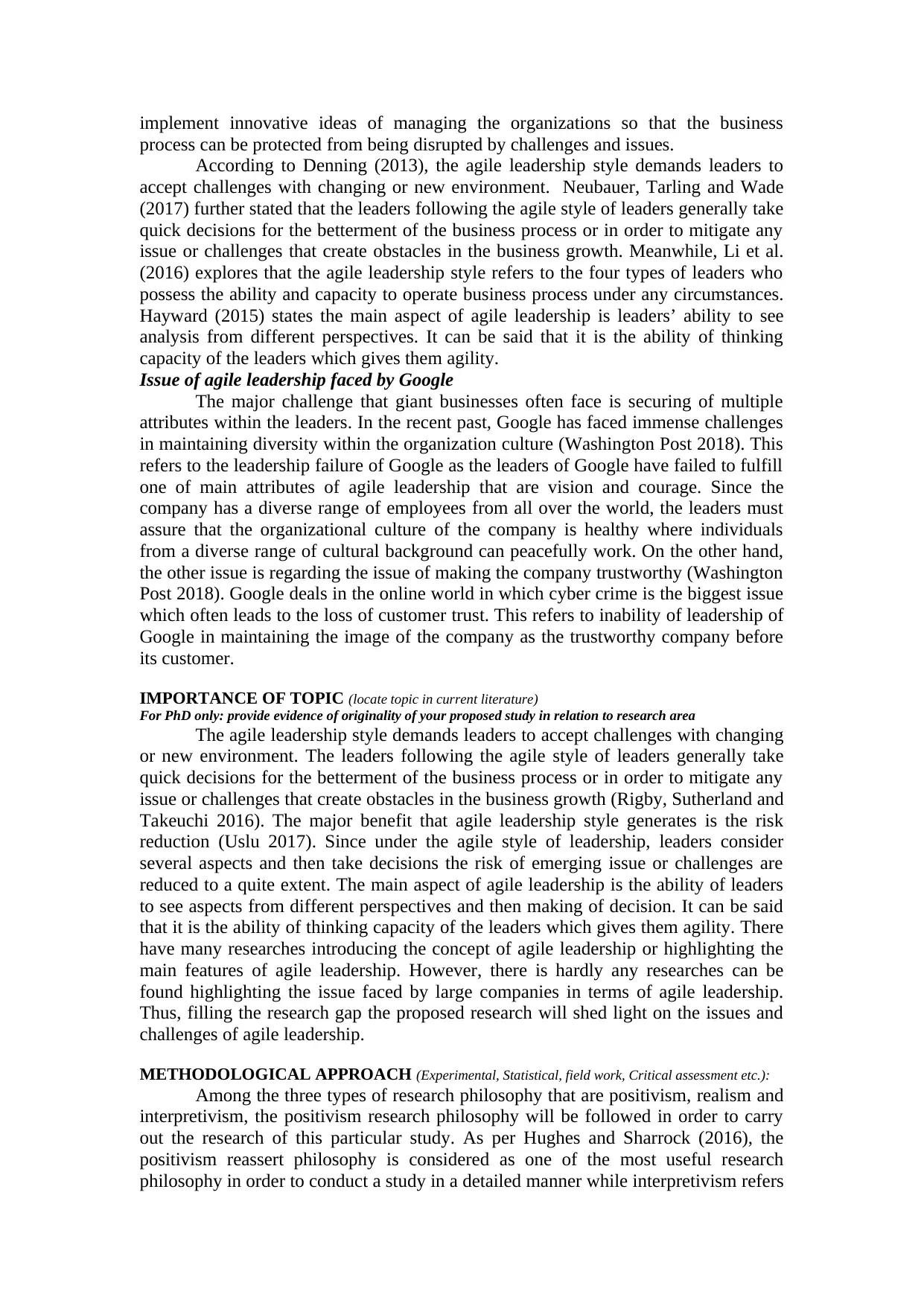
implement innovative ideas of managing the organizations so that the business
process can be protected from being disrupted by challenges and issues.
According to Denning (2013), the agile leadership style demands leaders to
accept challenges with changing or new environment. Neubauer, Tarling and Wade
(2017) further stated that the leaders following the agile style of leaders generally take
quick decisions for the betterment of the business process or in order to mitigate any
issue or challenges that create obstacles in the business growth. Meanwhile, Li et al.
(2016) explores that the agile leadership style refers to the four types of leaders who
possess the ability and capacity to operate business process under any circumstances.
Hayward (2015) states the main aspect of agile leadership is leaders’ ability to see
analysis from different perspectives. It can be said that it is the ability of thinking
capacity of the leaders which gives them agility.
Issue of agile leadership faced by Google
The major challenge that giant businesses often face is securing of multiple
attributes within the leaders. In the recent past, Google has faced immense challenges
in maintaining diversity within the organization culture (Washington Post 2018). This
refers to the leadership failure of Google as the leaders of Google have failed to fulfill
one of main attributes of agile leadership that are vision and courage. Since the
company has a diverse range of employees from all over the world, the leaders must
assure that the organizational culture of the company is healthy where individuals
from a diverse range of cultural background can peacefully work. On the other hand,
the other issue is regarding the issue of making the company trustworthy (Washington
Post 2018). Google deals in the online world in which cyber crime is the biggest issue
which often leads to the loss of customer trust. This refers to inability of leadership of
Google in maintaining the image of the company as the trustworthy company before
its customer.
IMPORTANCE OF TOPIC (locate topic in current literature)
For PhD only: provide evidence of originality of your proposed study in relation to research area
The agile leadership style demands leaders to accept challenges with changing
or new environment. The leaders following the agile style of leaders generally take
quick decisions for the betterment of the business process or in order to mitigate any
issue or challenges that create obstacles in the business growth (Rigby, Sutherland and
Takeuchi 2016). The major benefit that agile leadership style generates is the risk
reduction (Uslu 2017). Since under the agile style of leadership, leaders consider
several aspects and then take decisions the risk of emerging issue or challenges are
reduced to a quite extent. The main aspect of agile leadership is the ability of leaders
to see aspects from different perspectives and then making of decision. It can be said
that it is the ability of thinking capacity of the leaders which gives them agility. There
have many researches introducing the concept of agile leadership or highlighting the
main features of agile leadership. However, there is hardly any researches can be
found highlighting the issue faced by large companies in terms of agile leadership.
Thus, filling the research gap the proposed research will shed light on the issues and
challenges of agile leadership.
METHODOLOGICAL APPROACH (Experimental, Statistical, field work, Critical assessment etc.):
Among the three types of research philosophy that are positivism, realism and
interpretivism, the positivism research philosophy will be followed in order to carry
out the research of this particular study. As per Hughes and Sharrock (2016), the
positivism reassert philosophy is considered as one of the most useful research
philosophy in order to conduct a study in a detailed manner while interpretivism refers
process can be protected from being disrupted by challenges and issues.
According to Denning (2013), the agile leadership style demands leaders to
accept challenges with changing or new environment. Neubauer, Tarling and Wade
(2017) further stated that the leaders following the agile style of leaders generally take
quick decisions for the betterment of the business process or in order to mitigate any
issue or challenges that create obstacles in the business growth. Meanwhile, Li et al.
(2016) explores that the agile leadership style refers to the four types of leaders who
possess the ability and capacity to operate business process under any circumstances.
Hayward (2015) states the main aspect of agile leadership is leaders’ ability to see
analysis from different perspectives. It can be said that it is the ability of thinking
capacity of the leaders which gives them agility.
Issue of agile leadership faced by Google
The major challenge that giant businesses often face is securing of multiple
attributes within the leaders. In the recent past, Google has faced immense challenges
in maintaining diversity within the organization culture (Washington Post 2018). This
refers to the leadership failure of Google as the leaders of Google have failed to fulfill
one of main attributes of agile leadership that are vision and courage. Since the
company has a diverse range of employees from all over the world, the leaders must
assure that the organizational culture of the company is healthy where individuals
from a diverse range of cultural background can peacefully work. On the other hand,
the other issue is regarding the issue of making the company trustworthy (Washington
Post 2018). Google deals in the online world in which cyber crime is the biggest issue
which often leads to the loss of customer trust. This refers to inability of leadership of
Google in maintaining the image of the company as the trustworthy company before
its customer.
IMPORTANCE OF TOPIC (locate topic in current literature)
For PhD only: provide evidence of originality of your proposed study in relation to research area
The agile leadership style demands leaders to accept challenges with changing
or new environment. The leaders following the agile style of leaders generally take
quick decisions for the betterment of the business process or in order to mitigate any
issue or challenges that create obstacles in the business growth (Rigby, Sutherland and
Takeuchi 2016). The major benefit that agile leadership style generates is the risk
reduction (Uslu 2017). Since under the agile style of leadership, leaders consider
several aspects and then take decisions the risk of emerging issue or challenges are
reduced to a quite extent. The main aspect of agile leadership is the ability of leaders
to see aspects from different perspectives and then making of decision. It can be said
that it is the ability of thinking capacity of the leaders which gives them agility. There
have many researches introducing the concept of agile leadership or highlighting the
main features of agile leadership. However, there is hardly any researches can be
found highlighting the issue faced by large companies in terms of agile leadership.
Thus, filling the research gap the proposed research will shed light on the issues and
challenges of agile leadership.
METHODOLOGICAL APPROACH (Experimental, Statistical, field work, Critical assessment etc.):
Among the three types of research philosophy that are positivism, realism and
interpretivism, the positivism research philosophy will be followed in order to carry
out the research of this particular study. As per Hughes and Sharrock (2016), the
positivism reassert philosophy is considered as one of the most useful research
philosophy in order to conduct a study in a detailed manner while interpretivism refers
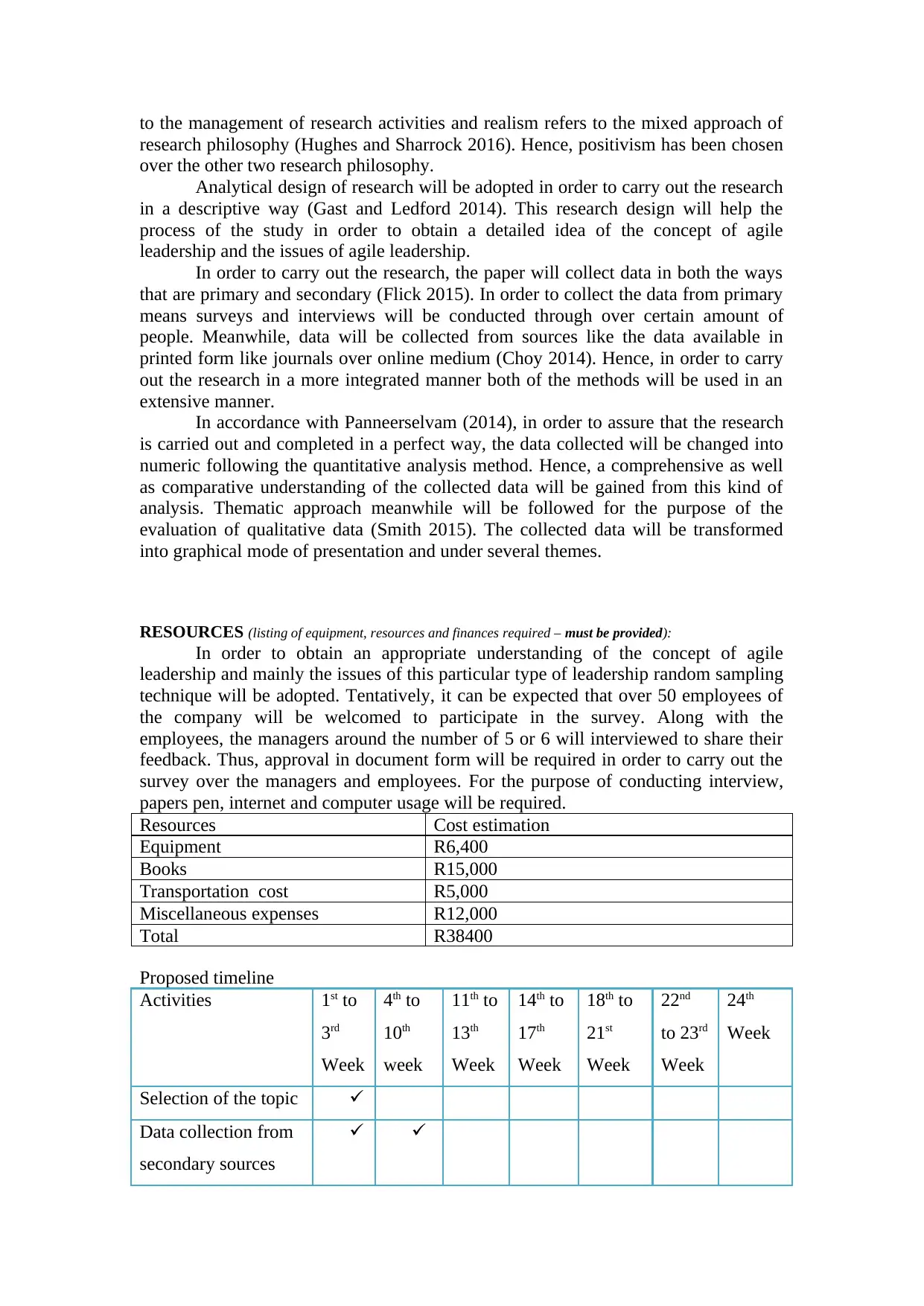
to the management of research activities and realism refers to the mixed approach of
research philosophy (Hughes and Sharrock 2016). Hence, positivism has been chosen
over the other two research philosophy.
Analytical design of research will be adopted in order to carry out the research
in a descriptive way (Gast and Ledford 2014). This research design will help the
process of the study in order to obtain a detailed idea of the concept of agile
leadership and the issues of agile leadership.
In order to carry out the research, the paper will collect data in both the ways
that are primary and secondary (Flick 2015). In order to collect the data from primary
means surveys and interviews will be conducted through over certain amount of
people. Meanwhile, data will be collected from sources like the data available in
printed form like journals over online medium (Choy 2014). Hence, in order to carry
out the research in a more integrated manner both of the methods will be used in an
extensive manner.
In accordance with Panneerselvam (2014), in order to assure that the research
is carried out and completed in a perfect way, the data collected will be changed into
numeric following the quantitative analysis method. Hence, a comprehensive as well
as comparative understanding of the collected data will be gained from this kind of
analysis. Thematic approach meanwhile will be followed for the purpose of the
evaluation of qualitative data (Smith 2015). The collected data will be transformed
into graphical mode of presentation and under several themes.
RESOURCES (listing of equipment, resources and finances required – must be provided):
In order to obtain an appropriate understanding of the concept of agile
leadership and mainly the issues of this particular type of leadership random sampling
technique will be adopted. Tentatively, it can be expected that over 50 employees of
the company will be welcomed to participate in the survey. Along with the
employees, the managers around the number of 5 or 6 will interviewed to share their
feedback. Thus, approval in document form will be required in order to carry out the
survey over the managers and employees. For the purpose of conducting interview,
papers pen, internet and computer usage will be required.
Resources Cost estimation
Equipment R6,400
Books R15,000
Transportation cost R5,000
Miscellaneous expenses R12,000
Total R38400
Proposed timeline
Activities 1st to
3rd
Week
4th to
10th
week
11th to
13th
Week
14th to
17th
Week
18th to
21st
Week
22nd
to 23rd
Week
24th
Week
Selection of the topic
Data collection from
secondary sources
research philosophy (Hughes and Sharrock 2016). Hence, positivism has been chosen
over the other two research philosophy.
Analytical design of research will be adopted in order to carry out the research
in a descriptive way (Gast and Ledford 2014). This research design will help the
process of the study in order to obtain a detailed idea of the concept of agile
leadership and the issues of agile leadership.
In order to carry out the research, the paper will collect data in both the ways
that are primary and secondary (Flick 2015). In order to collect the data from primary
means surveys and interviews will be conducted through over certain amount of
people. Meanwhile, data will be collected from sources like the data available in
printed form like journals over online medium (Choy 2014). Hence, in order to carry
out the research in a more integrated manner both of the methods will be used in an
extensive manner.
In accordance with Panneerselvam (2014), in order to assure that the research
is carried out and completed in a perfect way, the data collected will be changed into
numeric following the quantitative analysis method. Hence, a comprehensive as well
as comparative understanding of the collected data will be gained from this kind of
analysis. Thematic approach meanwhile will be followed for the purpose of the
evaluation of qualitative data (Smith 2015). The collected data will be transformed
into graphical mode of presentation and under several themes.
RESOURCES (listing of equipment, resources and finances required – must be provided):
In order to obtain an appropriate understanding of the concept of agile
leadership and mainly the issues of this particular type of leadership random sampling
technique will be adopted. Tentatively, it can be expected that over 50 employees of
the company will be welcomed to participate in the survey. Along with the
employees, the managers around the number of 5 or 6 will interviewed to share their
feedback. Thus, approval in document form will be required in order to carry out the
survey over the managers and employees. For the purpose of conducting interview,
papers pen, internet and computer usage will be required.
Resources Cost estimation
Equipment R6,400
Books R15,000
Transportation cost R5,000
Miscellaneous expenses R12,000
Total R38400
Proposed timeline
Activities 1st to
3rd
Week
4th to
10th
week
11th to
13th
Week
14th to
17th
Week
18th to
21st
Week
22nd
to 23rd
Week
24th
Week
Selection of the topic
Data collection from
secondary sources
Secure Best Marks with AI Grader
Need help grading? Try our AI Grader for instant feedback on your assignments.
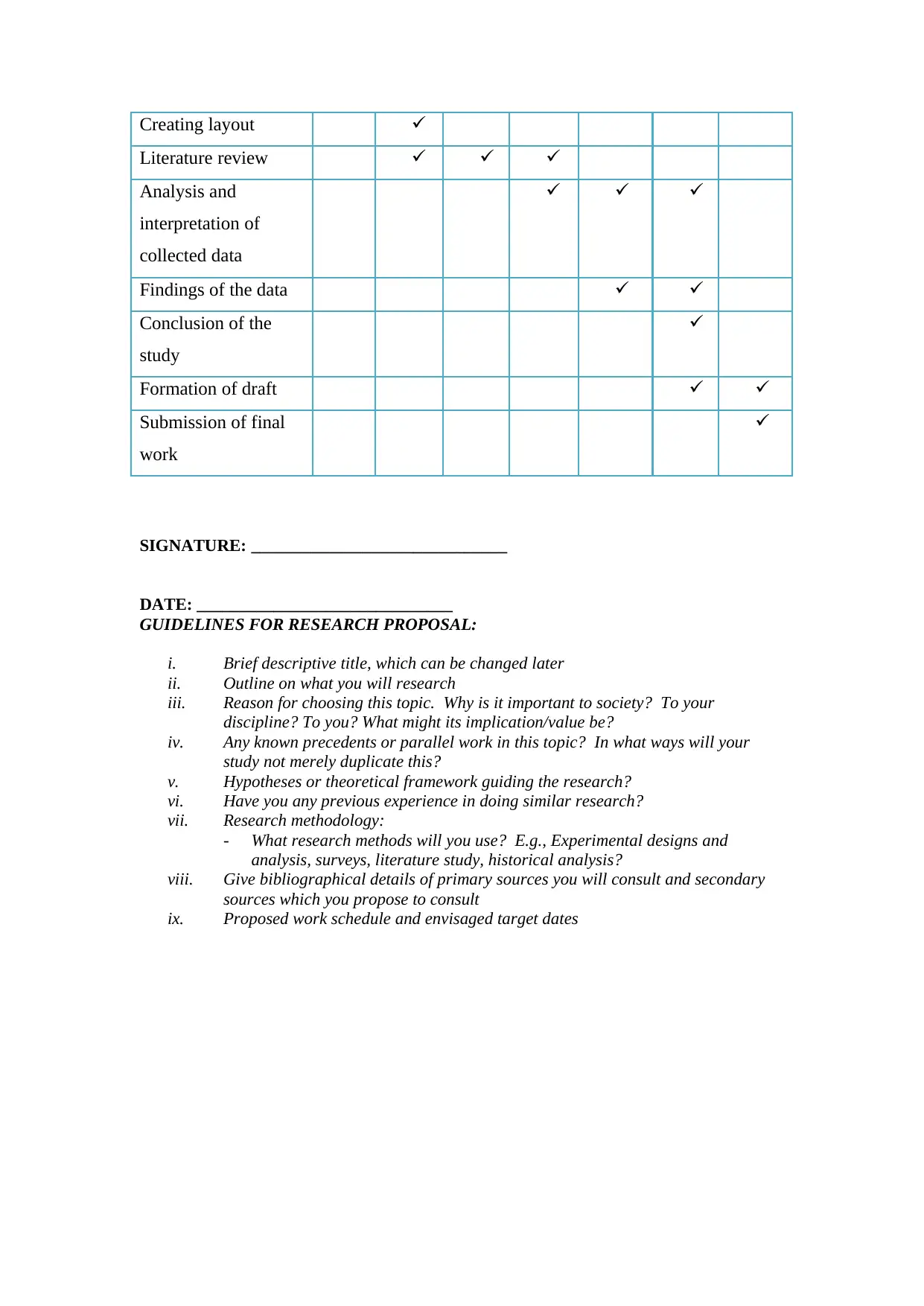
Creating layout
Literature review
Analysis and
interpretation of
collected data
Findings of the data
Conclusion of the
study
Formation of draft
Submission of final
work
SIGNATURE: ______________________________
DATE: ______________________________
GUIDELINES FOR RESEARCH PROPOSAL:
i. Brief descriptive title, which can be changed later
ii. Outline on what you will research
iii. Reason for choosing this topic. Why is it important to society? To your
discipline? To you? What might its implication/value be?
iv. Any known precedents or parallel work in this topic? In what ways will your
study not merely duplicate this?
v. Hypotheses or theoretical framework guiding the research?
vi. Have you any previous experience in doing similar research?
vii. Research methodology:
- What research methods will you use? E.g., Experimental designs and
analysis, surveys, literature study, historical analysis?
viii. Give bibliographical details of primary sources you will consult and secondary
sources which you propose to consult
ix. Proposed work schedule and envisaged target dates
Literature review
Analysis and
interpretation of
collected data
Findings of the data
Conclusion of the
study
Formation of draft
Submission of final
work
SIGNATURE: ______________________________
DATE: ______________________________
GUIDELINES FOR RESEARCH PROPOSAL:
i. Brief descriptive title, which can be changed later
ii. Outline on what you will research
iii. Reason for choosing this topic. Why is it important to society? To your
discipline? To you? What might its implication/value be?
iv. Any known precedents or parallel work in this topic? In what ways will your
study not merely duplicate this?
v. Hypotheses or theoretical framework guiding the research?
vi. Have you any previous experience in doing similar research?
vii. Research methodology:
- What research methods will you use? E.g., Experimental designs and
analysis, surveys, literature study, historical analysis?
viii. Give bibliographical details of primary sources you will consult and secondary
sources which you propose to consult
ix. Proposed work schedule and envisaged target dates
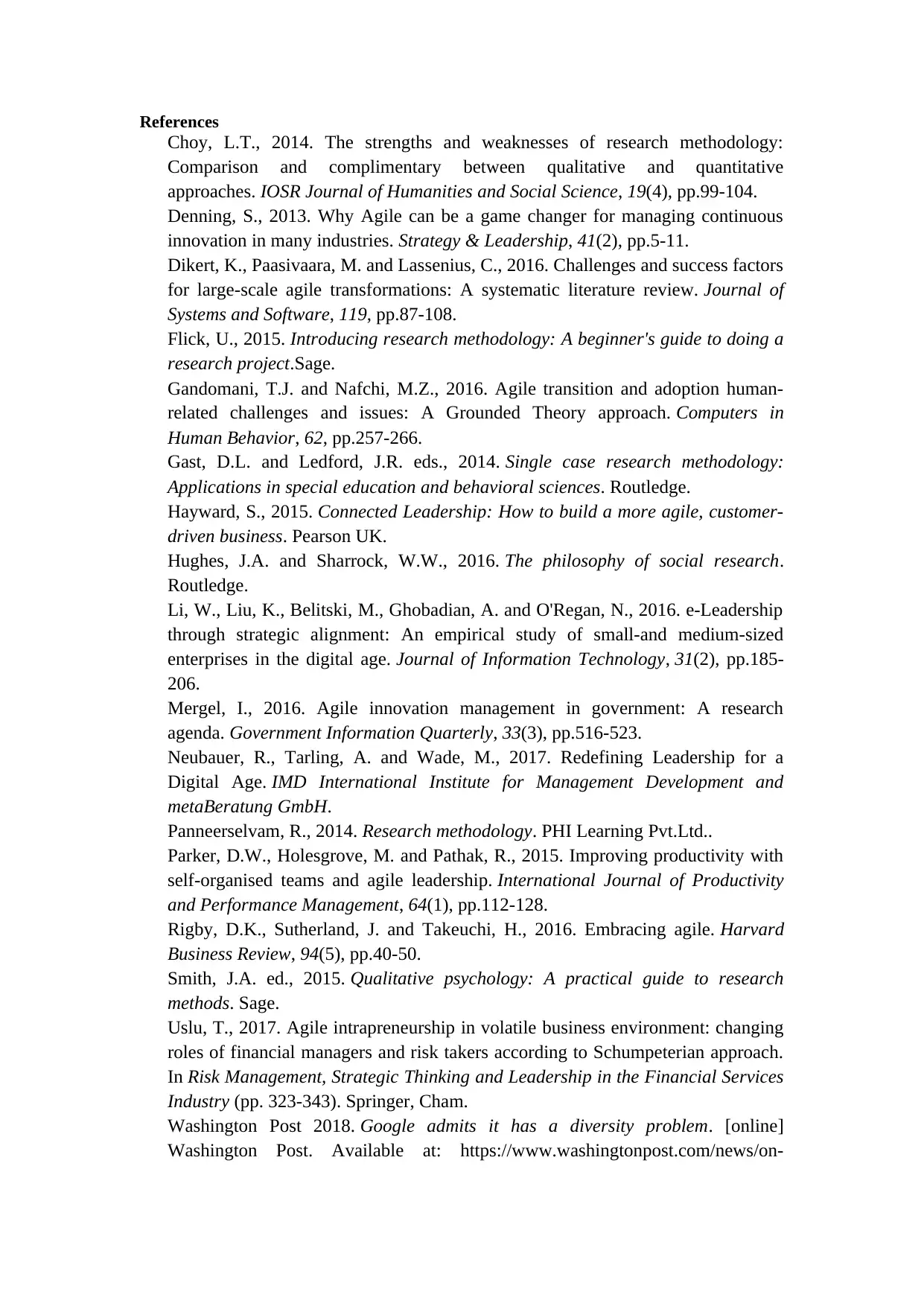
References
Choy, L.T., 2014. The strengths and weaknesses of research methodology:
Comparison and complimentary between qualitative and quantitative
approaches. IOSR Journal of Humanities and Social Science, 19(4), pp.99-104.
Denning, S., 2013. Why Agile can be a game changer for managing continuous
innovation in many industries. Strategy & Leadership, 41(2), pp.5-11.
Dikert, K., Paasivaara, M. and Lassenius, C., 2016. Challenges and success factors
for large-scale agile transformations: A systematic literature review. Journal of
Systems and Software, 119, pp.87-108.
Flick, U., 2015. Introducing research methodology: A beginner's guide to doing a
research project.Sage.
Gandomani, T.J. and Nafchi, M.Z., 2016. Agile transition and adoption human-
related challenges and issues: A Grounded Theory approach. Computers in
Human Behavior, 62, pp.257-266.
Gast, D.L. and Ledford, J.R. eds., 2014. Single case research methodology:
Applications in special education and behavioral sciences. Routledge.
Hayward, S., 2015. Connected Leadership: How to build a more agile, customer-
driven business. Pearson UK.
Hughes, J.A. and Sharrock, W.W., 2016. The philosophy of social research.
Routledge.
Li, W., Liu, K., Belitski, M., Ghobadian, A. and O'Regan, N., 2016. e-Leadership
through strategic alignment: An empirical study of small-and medium-sized
enterprises in the digital age. Journal of Information Technology, 31(2), pp.185-
206.
Mergel, I., 2016. Agile innovation management in government: A research
agenda. Government Information Quarterly, 33(3), pp.516-523.
Neubauer, R., Tarling, A. and Wade, M., 2017. Redefining Leadership for a
Digital Age. IMD International Institute for Management Development and
metaBeratung GmbH.
Panneerselvam, R., 2014. Research methodology. PHI Learning Pvt.Ltd..
Parker, D.W., Holesgrove, M. and Pathak, R., 2015. Improving productivity with
self-organised teams and agile leadership. International Journal of Productivity
and Performance Management, 64(1), pp.112-128.
Rigby, D.K., Sutherland, J. and Takeuchi, H., 2016. Embracing agile. Harvard
Business Review, 94(5), pp.40-50.
Smith, J.A. ed., 2015. Qualitative psychology: A practical guide to research
methods. Sage.
Uslu, T., 2017. Agile intrapreneurship in volatile business environment: changing
roles of financial managers and risk takers according to Schumpeterian approach.
In Risk Management, Strategic Thinking and Leadership in the Financial Services
Industry (pp. 323-343). Springer, Cham.
Washington Post 2018. Google admits it has a diversity problem. [online]
Washington Post. Available at: https://www.washingtonpost.com/news/on-
Choy, L.T., 2014. The strengths and weaknesses of research methodology:
Comparison and complimentary between qualitative and quantitative
approaches. IOSR Journal of Humanities and Social Science, 19(4), pp.99-104.
Denning, S., 2013. Why Agile can be a game changer for managing continuous
innovation in many industries. Strategy & Leadership, 41(2), pp.5-11.
Dikert, K., Paasivaara, M. and Lassenius, C., 2016. Challenges and success factors
for large-scale agile transformations: A systematic literature review. Journal of
Systems and Software, 119, pp.87-108.
Flick, U., 2015. Introducing research methodology: A beginner's guide to doing a
research project.Sage.
Gandomani, T.J. and Nafchi, M.Z., 2016. Agile transition and adoption human-
related challenges and issues: A Grounded Theory approach. Computers in
Human Behavior, 62, pp.257-266.
Gast, D.L. and Ledford, J.R. eds., 2014. Single case research methodology:
Applications in special education and behavioral sciences. Routledge.
Hayward, S., 2015. Connected Leadership: How to build a more agile, customer-
driven business. Pearson UK.
Hughes, J.A. and Sharrock, W.W., 2016. The philosophy of social research.
Routledge.
Li, W., Liu, K., Belitski, M., Ghobadian, A. and O'Regan, N., 2016. e-Leadership
through strategic alignment: An empirical study of small-and medium-sized
enterprises in the digital age. Journal of Information Technology, 31(2), pp.185-
206.
Mergel, I., 2016. Agile innovation management in government: A research
agenda. Government Information Quarterly, 33(3), pp.516-523.
Neubauer, R., Tarling, A. and Wade, M., 2017. Redefining Leadership for a
Digital Age. IMD International Institute for Management Development and
metaBeratung GmbH.
Panneerselvam, R., 2014. Research methodology. PHI Learning Pvt.Ltd..
Parker, D.W., Holesgrove, M. and Pathak, R., 2015. Improving productivity with
self-organised teams and agile leadership. International Journal of Productivity
and Performance Management, 64(1), pp.112-128.
Rigby, D.K., Sutherland, J. and Takeuchi, H., 2016. Embracing agile. Harvard
Business Review, 94(5), pp.40-50.
Smith, J.A. ed., 2015. Qualitative psychology: A practical guide to research
methods. Sage.
Uslu, T., 2017. Agile intrapreneurship in volatile business environment: changing
roles of financial managers and risk takers according to Schumpeterian approach.
In Risk Management, Strategic Thinking and Leadership in the Financial Services
Industry (pp. 323-343). Springer, Cham.
Washington Post 2018. Google admits it has a diversity problem. [online]
Washington Post. Available at: https://www.washingtonpost.com/news/on-
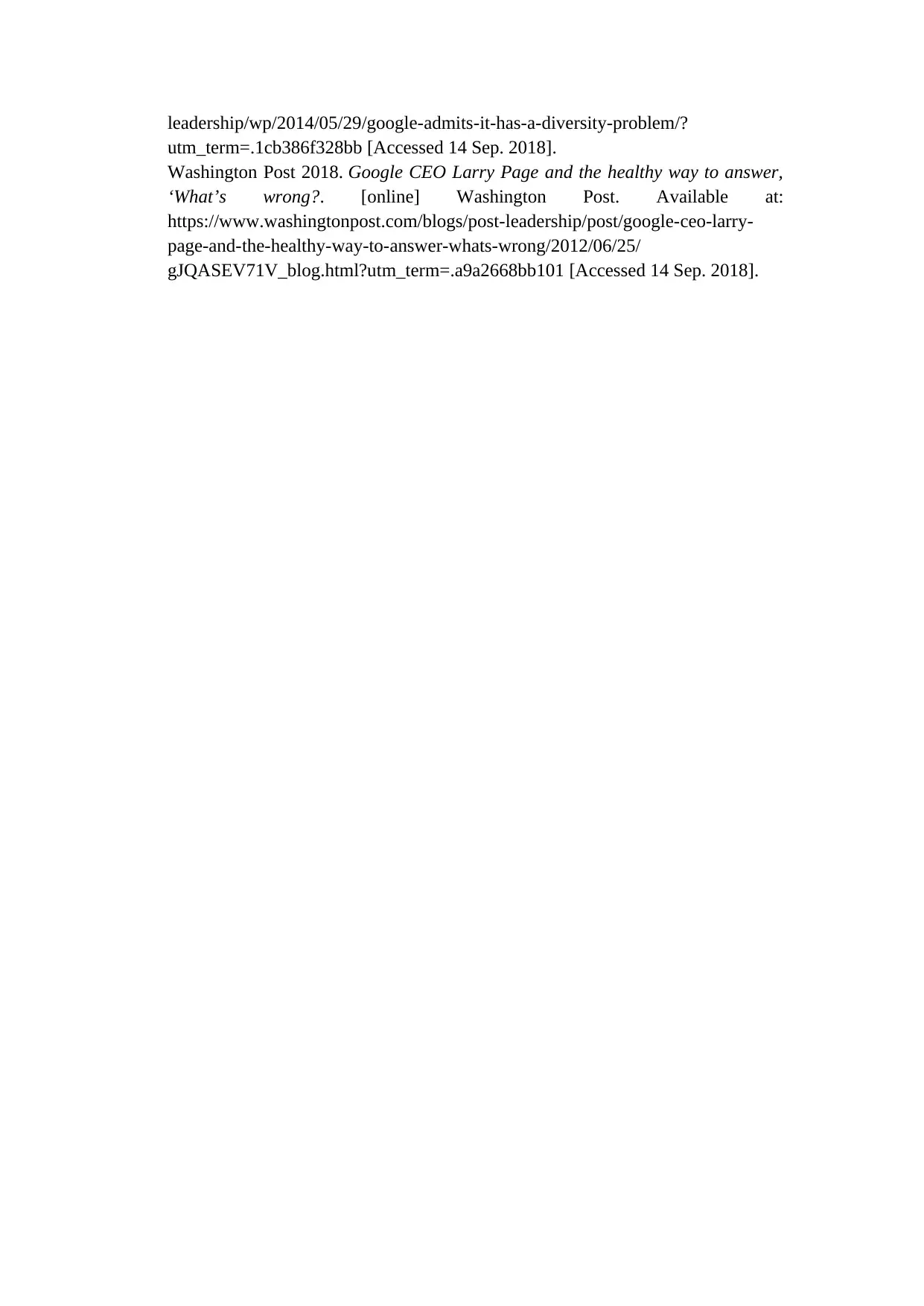
leadership/wp/2014/05/29/google-admits-it-has-a-diversity-problem/?
utm_term=.1cb386f328bb [Accessed 14 Sep. 2018].
Washington Post 2018. Google CEO Larry Page and the healthy way to answer,
‘What’s wrong?. [online] Washington Post. Available at:
https://www.washingtonpost.com/blogs/post-leadership/post/google-ceo-larry-
page-and-the-healthy-way-to-answer-whats-wrong/2012/06/25/
gJQASEV71V_blog.html?utm_term=.a9a2668bb101 [Accessed 14 Sep. 2018].
utm_term=.1cb386f328bb [Accessed 14 Sep. 2018].
Washington Post 2018. Google CEO Larry Page and the healthy way to answer,
‘What’s wrong?. [online] Washington Post. Available at:
https://www.washingtonpost.com/blogs/post-leadership/post/google-ceo-larry-
page-and-the-healthy-way-to-answer-whats-wrong/2012/06/25/
gJQASEV71V_blog.html?utm_term=.a9a2668bb101 [Accessed 14 Sep. 2018].
1 out of 7
Related Documents
Your All-in-One AI-Powered Toolkit for Academic Success.
+13062052269
info@desklib.com
Available 24*7 on WhatsApp / Email
![[object Object]](/_next/static/media/star-bottom.7253800d.svg)
Unlock your academic potential
© 2024 | Zucol Services PVT LTD | All rights reserved.





